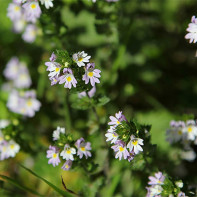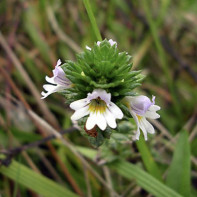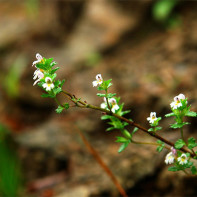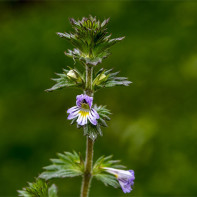Ochanka: medicinal properties and contraindications
The eyeball medicinal plant is famous throughout Europe and in some Asian countries as a powerful remedy for a number of diseases. It is highly valued, as it has a pronounced therapeutic effect in diseases of the eyes, stomach, and skin. There are several varieties of this herb, but not all of them are equally useful. To use the healing power of a plant, it is important to know how it looks, what it is useful for and how to use it correctly.
- Chemical composition
- How it looks and where it grows
- Collection and storage
- The healing properties of herb euphrasia
- The use of eyebright in traditional medicine
- For eye diseases
- With gastritis and colitis
- With hepatitis
- With diseases of the bronchi and lungs
- With skin diseases
- With nicotine addiction
- Application in cosmetology
- Types of healing compounds with eyebright
- Infusion
- Tincture
- Decoction
- Tea
- Eyebright Pharmacy
- Contraindications
Chemical composition
For the first time, the Austrian scientist R. Wetstein in 1896 was able to isolate the type of drug eye. But still this plant is an object of interest of scientists. Practice shows that it has a powerful therapeutic potential, which to this day is not fully understood. But even the information that science has already managed to get enough to know the characteristics of the chemical composition of plant materials and its impact on the human body. Through analysis and research, scientists were able to find out that the following components are contained in the grass:
- glycosides;
- essential oils;
- flavonoids;
- lignan;
- aucubin;
- catallol;
- tannins;
- bitterness;
- anthocyanins;
- coumarins;
- zinc;
- manganese;
- copper;
- iron;
- potassium;
- silicon;
- chromium;
- organic acids.
This list of substances in the complex has a beneficial effect on the nervous system, cleanses the vessels and strengthens them. Due to the synergy effect, the total effect of all components is higher than each separately. Therefore, it is precisely such a set of components and their high concentration that provides a pronounced therapeutic effect. This allows the use of grass in the complex treatment of chronic and acute diseases.
How it looks and where it grows
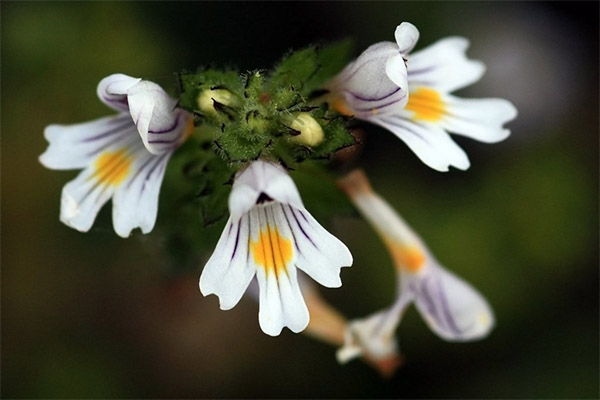
Ophthalmus officinalis is a representative of the genus Ochanka, the Zarazikhov family. This species has pronounced healing properties and is widely used for the treatment of various diseases. This herbaceous plant has a one-year development cycle, propagated by seeds. Botanical characteristics:
- maximum plant height - up to 20 cm;
- leafy stems;
- saturated green leaves with a serrated edge, small;
- inflorescences are asymmetric, axillary, milky white with a yellow core.
After flowering, small seeds are formed. Flowering dates do not always coincide in different regions. In Russia, the plant is common in all regions, but in the southern part the flowering phase activates in late June, and in the northern part you can admire the opened inflorescences and start collecting raw materials only in August. It is necessary to search for euphorbia in the fields, at the edges of forests, it grows and other species of plants survive along paths in plantings and groves.
You can grow eyebright at home, but for this you need to collect the seeds on time, when they ripen well. In the middle lane this occurs around the first half of September. Seeds should be left for the winter in the freezer, where they will be stratified and get rid of possible diseases that many wild plants are infected with.
For the cultivation of eyebright, you need to select a separate site, preferably away from the main plantings. The fact is that this parasitic plant can lead to the destruction of vegetable crops. Moreover, the eyeball grows and captures new territories quickly enough, propagating by self-sowing. You need to monitor this and cut the grass in time during the flowering period before the wind disperses the seeds.It is not demanding on soil, but grows better on loams with neutral acidity.
Collection and storage
The collection of plant materials must be strictly according to the rules. Non-observance of precautionary measures or violation of the terms of harvesting will cause the grass to be useless or even dangerous. Here are the basic rules regarding collection:
- Cutting plants along highways and industrial facilities is strictly prohibited, since harmful and carcinogenic toxins accumulate in them.
- It is necessary to carry out the collection in the morning in sunny weather, as soon as the dew dries on the grass.
- To harvest grass, you need to use only clean containers and work with gloves, since you can’t wash the raw materials before drying.
The beginning of flowering eye falls in the second half of summer. The optimal time for collecting raw materials is August. In September, you can also cut grass, but you need to choose the most serene periods. It is important that there is no rain for 5-6 days before harvest. Here is a step-by-step instruction on harvesting:
- Cut off the aerial part of the plant, without roots.
- Lay in small bundles and bandage with natural wool or cotton thread.
- Tie down inflorescences in the attic or under a canopy to dry the raw materials.
- Make sure that direct sunlight does not fall on the grass, there is no increased humidity.
Grind completely dried grass with scissors and put in a dry container for storage. To preserve the healing properties and aroma of the plant, it is necessary to tightly close the container. Glass and tin cans are well suited for these purposes. It is undesirable to use plastic and fabric bags for storage. In synthetic containers, plant materials can absorb toxic substances, and in the tissue they evaporate essential oils and become less effective for treatment.
You can also wait until the flowering ends and collect the seeds. An oil is prepared from them, which is used in cosmetology and the treatment of skin diseases. Seeds can be steamed with boiling water and drunk with gastritis, colitis, gastric ulcer and flatulence. They accumulate fats and fatty acids in themselves, which stimulate tissue regeneration and heal wounds. Also, these components contribute to the strengthening and restoration of the nervous system after stress and great emotional or mental stress.
The maximum storage time is 2 years. In order to preserve all the valuable properties of the grass for such a long period, it is important to organize suitable conditions:
- There should not be anything in the room that gives off a pungent odor.
- Medicinal raw materials should be stored in a warm place where there are no frequent temperature changes.
- It is important to protect the grass from direct sunlight.
Of course, it is worth hiding the prepared raw materials away if there are children or animals in the house. Improper use is fraught with negative consequences for the body and poisoning.
The healing properties of herb euphrasia
Properly collected and harvested grass has a pronounced therapeutic effect. To get the maximum benefit from its use, it is important to know in which situations it helps to overcome health problems. The following are the beneficial properties of this plant that science has been able to identify to date.
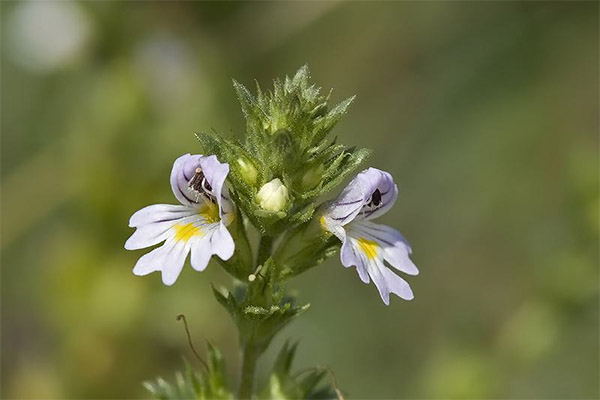
- Anti-inflammatory effect is pronounced both with external and internal use. Thanks to the presence of flavonoids and coumarins, herb-based products soothe and relieve inflammation in infectious diseases and allergic reactions.
- The antibacterial effect is expressed only with topical application. The herb is effective in combating skin infections caused by pathogenic microflora. Also, when ingested, an infusion of grass destroys Helicobacter (the bacterium that causes gastritis), and some types of intestinal infections.
- The hypotonic effect is used to lower blood pressure in hypertension.
- The diuretic effect is used to quickly remove excess fluid from the body, as well as to cleanse the kidneys.
- The choleretic properties of the grass are due to the presence of bitterness in its composition.This feature is used for congestion in the liver and gall bladder.
- The antitussive effect of eyebright is used for acute respiratory viral infections, bronchitis, and pneumonia. Infusion and tea from the herb dilutes sputum and speeds up its excretion.
- The hepatoprotective effect of euphrasia is known even to traditional medicine; therefore, it is recommended to use grass in collections for chronic liver diseases. It stimulates the regeneration of hepatocytes (liver cells), normalizes metabolism, and prevents the development of cirrhosis in viral hepatitis.
- A mild laxative effect will help to quickly cleanse the intestines, normalize the digestion process and remove accumulated toxins from the body.
- Eyebright normalizes the release of enzymes necessary for the full digestion and assimilation of food, so it is used immediately before meals.
- Eyebright helps to cope with nicotine addiction and is used to additionally cleanse the lungs of tar and heavy metals that accumulate in the body over many years of bad habit.
- The calming effect of eyebright is also used for inflammation and eye fatigue. The complex of biologically active components helps in the presence of boils, inflammation of the mucous membrane. In addition, the eyeball when applied inside normalizes the functioning of the optic nerve and muscles, strengthens the eyeball and the lens, due to which it is possible to restore vision.
As you can see, the eyeball is a powerful natural remedy that can support the body, stimulate its recovery, and also provide protection against various diseases.
The use of eyebright in traditional medicine
Eyebright is recognized as one of the most effective plants for diseases of the eyes, respiratory system and digestive tract. It can be used separately or supplemented with other varieties of medicinal plants to enhance the effect. For various diseases, the treatment regimen, prescriptions, and the combination of herbs with other ingredients are different.
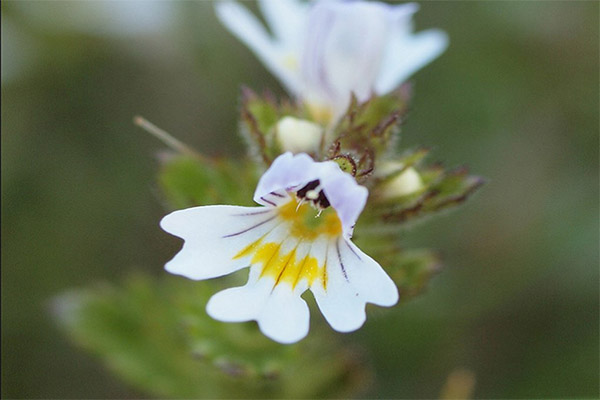
For eye diseases
The eyebright is also called “eye grass”, as it helps to cope with diseases that affect this part of the body. Important application rules:
- make sure there is no allergic reaction;
- treat the hands with an antiseptic before use;
- for compresses use only a sterile bandage.
Infusion for compresses is prepared in a clean bowl of 200 ml of water and 1 tablespoon of grass. In case of inflammation of the mucous membrane, redness and fatigue, cold compresses should be done. If the eyes are affected by a bacterial infection, you can use a warm infusion. Compress is applied for 10 minutes, 3 times a day. The duration of treatment is from 2 to 8 weeks.
To enhance the effect of topical application, it is recommended to use tea from the pupil internally, ½ cup 3 times a day. You can prepare drops for wetting and washing the eyes according to this recipe:
- 1 teaspoon of chamomile;
- a pinch of fennel seed;
- 1 tablespoon of eyebright;
- 200 ml of boiling water.
Pour the mixture of herbs and insist under a closed lid until it cools completely. Use liquid for washing the eyes with a syringe. You can simply wipe your eyelids with a cotton pad dipped in infusion, 4–5 times a day.
With gastritis and colitis
Diseases of the stomach can be treated with alcohol or vodka tincture of the herb. The dosage differs depending on the type of product:
- on alcohol - 20 drops 3 times a day for 3 weeks;
- on vodka - 30 ml 3 times a day for 1 month.
Taking the medicine is strictly 10-15 minutes before eating. It is necessary to combine treatment with diet - avoid acidic, fried, spicy and fatty foods.
With hepatitis
Eyebright is effective in viral and toxic hepatitis, but only at those stages when liver function is fully preserved. Reception is relevant for minor violations of the liver. In the case of the development of acute hepatitis, it is necessary to stop taking it for a while, since there is a risk of worsening the condition. After achieving remission, treatment can be resumed.For the treatment of hepatitis, a 6-month regimen is used:
- Three times daily intake of eye powder ½ teaspoon for 2 months.
- 1 month break.
- Twice taking 50 ml of infusion for 2 months.
- A single intake of water infusion in a volume of 50 ml for the remaining 30 days.
2 months after the completion of the first stage, it is necessary to undergo a diagnosis to determine how the drug works, undergo an ultrasound of the abdominal organs, and also perform a biochemical blood test.
Hepatitis is a chronic disease with a sluggish inflammatory process, so you should not rely only on grass. It is necessary to use it in combination with the main therapy as an adjuvant.
With diseases of the bronchi and lungs
In chronic bronchitis, pneumonia and lingering cough, a decoction is used for inhalation and oral administration. To prepare a decoction, you need to take 2 tablespoons of grass and pour 500 ml of cold water. Boil under a closed lid over low heat, when it boils, wait 3 minutes and turn it off. Breathe the infusion 3 times a day with steam, but do not go out into cold air after the procedure for 2 hours. Therefore, to cure a cough, you need to properly plan your time.
Inside, you need to take the same decoction, but drink it in small portions - 40 ml, every 3-4 hours. During treatment, it is advisable to avoid contact with cold air and be sure to drink plenty of fluids to thin out sputum.
Bronchial asthma is a dangerous condition in which any herbal remedy can cause a severe allergic reaction up to swelling of the larynx, which can lead to respiratory arrest. It is also dangerous to use herbs for bronchospasm. Eyebright is effective in such conditions, but before use you need to conduct an allergy test and consult your doctor.
With skin diseases
Infectious or allergic skin dermatitis, furunculosis and inflammation are most effectively treated locally. For this, you can use a decoction of eyebright. There are three types of procedures using this medicinal raw material that are effective in treating skin diseases:
- wiping;
- compresses;
- baths.
In the presence of a pronounced, acute inflammatory process or boils, prolonged contact with moisture is contraindicated, so it is better to use alcohol tincture or wipe with a water decoction. If there are long non-healing ulcers, irritation and slight inflammation, you can take baths with infusion of herbs - 100 grams per 3 liters of water.
With nicotine addiction
Due to the ability to affect the human nervous system, the grass can be used by those who want to quit smoking. But it’s important to understand that this is not a panacea. Eyebright only helps to normalize the condition during the period of failure and to cope with the obsessive desire to return to addiction.
For the treatment of smoking addiction, a strong extract of eyebright is used in its pure form, it can not be diluted with water. An infusion of 250 ml of boiling water and 3 tablespoons of herb is prepared. You need to drink it 1 tablespoon before meals for 3 weeks. During this time, the body will cleanse, and the desire to smoke will pass.
To achieve maximum effect, you can use a mixture of two herbs:
- thyme (inflorescences);
- eyebright.
Mix vegetable raw materials in equal proportions, brew in the same concentration - 250 ml 3 tablespoons. Insist and strain, keep in the refrigerator. Drink for 3-4 weeks. It is also important for the duration of treatment to avoid temptations and not to contact with smokers. If during the day there is a strong desire to smoke a cigarette, you should chew a pinch of dry grass powder.
Application in cosmetology
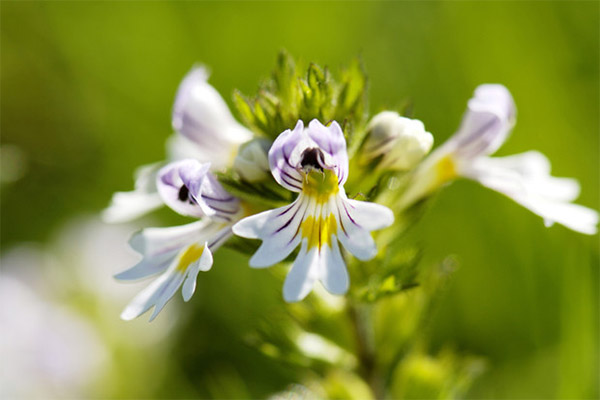
The abilities of eyebright since ancient times are known to women. In the old days there was not a lot of caring cosmetics for the beauty of skin and hair, so the ancestors had to use only the power of nature. Eyebright can still help you look attractive if you use it to look after your appearance.This herb can solve such problems:
- acne, acne;
- peeling and inflammation of the skin;
- enlarged and clogged pores;
- loss of skin elasticity;
- dandruff;
- baldness;
- weakening of the hair bulb;
- slow hair growth;
- rosacea.
To use the power of this herb, you can adopt several classic recipes and methods of application.
- In case of acne, it is useful to use a trap of eyebright to wipe the face every 4-5 hours. At the time of treatment, you need to abandon decorative cosmetics.
- Peeling of the skin and a tendency to inflammation is best treated with oily ointment from the eye. You need to insist 3 tablespoons of raw materials in olive oil for 21 days, and then decant and apply 2 times a day.
- When clogging the pores, it is worth steaming the face with an infusion of grass, and then wiping it with a cotton pad soaked in alcohol tincture. Repeat the procedure 2-3 times a week.
- There are two ways to restore healthy skin turgor. Wipe your face 2 times a day with ice cubes made from a strong infusion of grass. Instead of ice, you can use simply chilled liquid, applying it to the skin with a cotton pad.
- From dandruff, an infusion is used to rinse hair. It is necessary to cook it immediately before use - take 1 tablespoon of boiling water 2 tablespoons of raw materials and leave for 30 minutes. Use every evening for 2 weeks.
- You can stop hair loss with a mask from 1 tablespoon of honey, the same volume of castor oil and 30 drops of alcohol tincture. Hold the mask for 1 hour, repeat every 3 days. The same recipe is effective in weakening the hair follicle, for the treatment of dull and damaged hair.
- To stimulate hair growth and make them healthier, you need to use this mask: 1 teaspoon of turmeric, egg yolk, 30 drops of infusion, 1 teaspoon of olive oil. Rub into hair roots and leave for 20 minutes, repeat every other day.
- With rosacea, the use of cold compresses from infusion is effective. It is necessary to apply a bandage soaked in water, for 10-15 minutes every evening for 30 days.
All these recipes are equally good, but only if the person is not allergic to the plant or other components of the drugs. Otherwise, they will only harm health, appearance and create additional problems that are not always easy to eliminate.
Types of healing compounds with eyebright
You can prepare medicines from the eyebright at home. To do this, you need to know the basic recipes and proportions. Otherwise, the drugs will turn out to be too strong or will not have the desired concentration of active substances. Do not experiment with your health, it is better to choose classic recipes that have been tested by time and have proven their safety and effectiveness for the preparation of medicinal compositions.
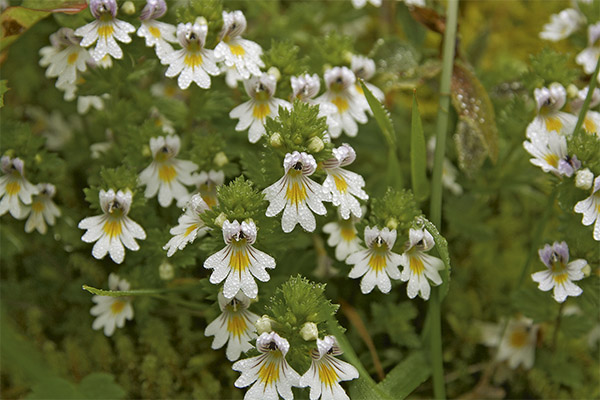
Infusion
Water infusion is a liquid dosage form in which up to 40-50% of the active ingredients from plant materials are present. In this form, it can be taken by absolutely everyone, even those who are diagnosed with liver diseases (in the presence of such problems, the use of alcohol and vodka tinctures is strictly contraindicated).
The recipe for cooking is simple and quick - make a cup of boiling water 1 teaspoon (with a slide) of plant material, cover the dish with a lid. The preparation time of such a tool is 30 minutes. After that, take a fine sieve or cheesecloth, strain the liquid so that there are no residues of raw materials in it, and divide the resulting medicine into 3 servings. You need to cook this infusion daily, and store it throughout the day in the refrigerator. Bring fluid to room temperature before use. The infusion helps with such pathologies:
- fatty liver disease (21 day course in conjunction with a diet);
- psoriasis (3 courses of one and a half weeks with a break of 2-3 days);
- allergic skin reactions - externally for wiping and compresses 2-3 times a day;
- gastritis (for 7-10 days before each meal, 50 ml);
- inflammation of the eyes (compresses 2 times a day).
Infusion can be prepared in a thermos. The proportions must be observed - take 1 teaspoon of grass in a 200 ml cup. That is, if the thermos is 0.5 l, then you need to pour 2.5 teaspoons of the raw material into it.
Tincture
Alcohol tincture is a type of medicine in which it is possible to extract a maximum of valuable substances from raw materials, up to 80%. Alcohol is an organic solvent that breaks down the constituents of herbs at the molecular level, so it is best to use alcohol tincture to treat serious diseases that require an increased dosage of active substances.
Here's what you need to prepare this type of medicine:
- 200 ml of medical alcohol;
- 2 tablespoons of medicinal dry raw materials;
- dark glass bottle with sealed cap.
It is necessary to pour grass in the container, pour alcohol and leave in a dark place for 2 weeks, shake every 3 days. After that, nothing useful remains in the plant material, therefore, the tincture must be filtered into a clean container and closed. Drink 20 drops before each meal, but the course should not be longer than 30 days. Such tincture can be stored for no longer than 2 years, but if sediment appears during use, you need to sediment the liquid and gently strain through several layers of gauze or a cotton filter.
Decoction
The broth can be prepared immediately for 3 days, if there is a need for regular admission. But you need to know how to cook it properly so as not to spoil the raw materials. The fact is that the composition of the grass includes substances that quickly evaporate with the evaporation of the liquid. Therefore, you need to cook the broth strictly under a closed lid and insist in the same way. The broth is stored in the refrigerator in a closed bottle. You can not use it if there is an unpleasant odor. The maximum shelf life is 4–5 days.
Tea
Aromatic tea can also be prepared from the grass, which is distinguished by its delicate taste and aroma. This is the safest type of medicine, since the concentration of active substances is quite low. The duration of tea treatment is from 10 days to 2 months. Such a dosage form is effective for the following diseases:
- Chronical bronchitis;
- angina;
- ARVI;
- pneumonia;
- chronic obstructive pulmonary disease (COPD);
- hypertension;
- swelling
- cholecystitis.
Tea is prepared from ½ teaspoon of raw materials, which must be poured with boiling water and infused for 3-5 minutes. You can boil vegetable raw materials. Tea for colds, viral and bacterial infections can be taken with honey, lemon and grated ginger root to enhance the effect. Rules for using tea:
- amount - 150 ml per 1 dose;
- time - 15 minutes before a meal;
- frequency of use - 3-5 times a day.
It is important to combine the intake of tea with a plentiful drink, since it has a pronounced diuretic effect. Loss of fluid in diseases is dangerous for the body, as homeostasis and water-salt balance are disturbed, toxins accumulate in the body.
Eyebright Pharmacy
For several decades now, the pharmaceutical industry has been using extract from vegetable raw materials as an essential component for preparations.
- Bilberry-F - a means to restore vision, in which extracts of two medicinal plants are combined. Blueberries complement the properties of eyebright.
- Eyebright in capsules - a drug that is designed for long-term treatment of eye diseases, helps restore vision with myopia.
- Faurin - eye drops used in conjunctivitis and infectious diseases of the eye.
- Starry eye - capsules in which the herb extract is supplemented with vitamins that restore vision.
Any ophthalmic preparations can be used only as directed by a doctor. Self-medication is dangerous and fraught with negative consequences for the whole body. Before using pharmaceuticals, you need to study the instructions in detail and pay attention to the list of contraindications - they differ for each drug, since auxiliary components are used.
Contraindications
If you do not use herbal remedies or pharmacy preparations based on eyebright, you can harm your health. Therefore, it is important to know in which cases the use of this herb is contraindicated.
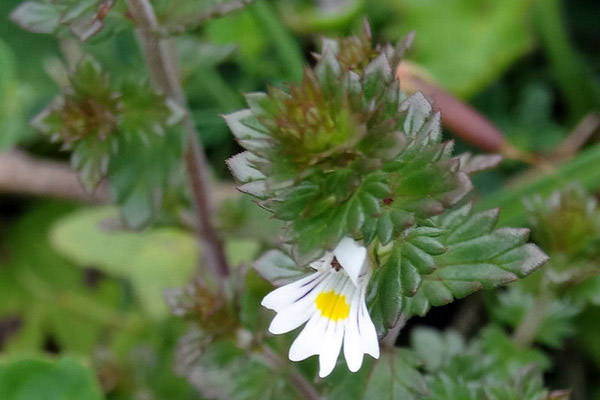
- Pregnancy is a period when it is better to refrain from internal intake of drugs and funds based on herbs. Outwardly, you can use the plant, but only with the permission of the doctor.
- Breastfeeding is one of the stages when it is better to completely exclude the use of plant materials and eyebright preparations. The fact is that the active components that make up the grass are able to penetrate into mother’s milk, and together with it, into the baby’s body. It is dangerous for severe allergic reactions and other negative consequences.
- If gastritis with low acidity is detected, this is also an occasion to refuse to ingest funds based on herbs. It further inhibits the secretion of gastric juice, which can cause disruptions in the digestion of food and pain.
- Hypotension is another categorical contraindication. The use of medications or home remedies, which include eyebright, can drastically lower blood pressure, which can even provoke a violation of cardiac activity and fainting.
- An exacerbation of gallstone disease, accompanied by blockage of the bile ducts, is also an occasion to cancel the intake of grass. The fact is that the plant components stimulate the secretion of bile, and if the ducts are blocked, it cannot exit normally, which is dangerous due to rupture of the bladder and peritonitis.
- An allergic reaction or hypersensitivity to plant materials is also a reason to abandon its use. To identify the presence of allergies, it is enough to test the remedies based on herbs on the area of sensitive skin on the wrist - apply and wait 30-40 minutes. If the skin turns red or itching occurs, you cannot use such medications.
It is also forbidden to use eyebright in pediatric practice for patients under three years of age. For older children, externally, based on eyebright, can be used externally, but only after consulting a pediatrician and a specialist in the field of herbal medicine.
Eyebright is a medicinal plant for many diseases. If you use it correctly, in the absence of contraindications, you can significantly accelerate the process of recovery of the body and protect it from the negative consequences of diseases.
«Important: all information on the site is provided exclusively in fact-finding purposes. Before applying any recommendations, consult with a profile specialist. Neither the editors nor the authors are liable for any possible harm caused materials. "

